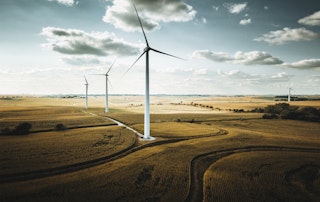Norway features some of Europe’s best wind resources, and onshore wind power is the production technology with the lowest development cost in Norway. Continued onshore wind power development is therefore important in meeting the expected increase in Norwegian and European power consumption.
This article was last updated 18 November 2025.
Licence application processing for onshore wind power was suspended in April 2019. The licensing process for onshore wind was fully reopened in 2023.
New rules on the permitting process for onshore wind power projects
The resumption of licence application processing for new projects came in the wake of new regulatory framework guidance from the Parliament.
Requirement for an area zoning plan before the licensing process 1 July 2023, new rules were imposed to the license application processing of onshore wind-power projects. The new rules give municipalities greater control by making a license conditional upon the municipalities having adopted an area zoning plan (Nw: områderegulering) under the Planning and Building Act. At the same time, the Ministry of Energy’s ability to give licenses the effect as a central government land-use plan (Nw: statlig arealplan) has been repealed. This gives municipalities decisive influence over whether a wind farm project can be established.
For wind-power developers, the requirement for an area zoning plan means, among other things, that several important details must be clarified at an earlier stage of the project.
An exemption from the requirement for an area zoning plan may be granted if the primary land use conditions (Nw: overordnede arealmessige forutsetninger) have been sufficiently examined in another planning decision, for example in a municipal master plan, to the same extent and established with the same level of detail as required for an area zoning plan. This is an exception intended to prevent unnecessary duplicate processes in the municipality, particularly where the municipal master plan has been recently adopted.
Changes in the area zoning plan
Once a facility licence under the Energy Act is granted, the zoning plan cannot be changed in ways that conflict with the licence unless the Ministry of Energy consents—typically only if new information has emerged. Consent should not be given for changes affecting the project’s profitability or production.
Before a licence is granted, the municipality may change the zoning plan without Ministry consent, for example based on new information from the licensing process.
No Ministry consent is required if the developer proposes the zoning change.
Division of roles: zoning vs. licensing
The area zoning plan shall set the main land-use conditions for the wind farm, such as:
- visibility of turbines from specified mapped areas,
- maximum turbine height,
- no-go/undisturbed areas,
- other high-level requirements.
NVE sets the detailed design through licence conditions and the detailed plan (e.g., internal road placement, number of turbine locations, maximum installed capacity, turbine dimensions).
The zoning plan’s premises must be clearly specified in maps and provisions to enable checking licence compliance.
New EIA requirements and standard licence terms
Following the 2022 wind power white paper (Meld. St. 28 (2019-2020), NVE issued recommendations for new licenses requirements new standard conditions set out in the licences. NVE will apply stricter EIA requirements (methods, competence) and address new topics like public health and biodiversity, aiming for more thorough and consistent assessments.
The new standard conditions set out in the facility license will include specifics like: maximum turbine height, minimum distance to buildings, and tighter deadlines for submitting the detailed plan and for construction. NVE also aim to apply new principles on pre‑ and post‑construction studies, with stronger emphasis on environment, neighbours, and other users.
The licensing process for onshore wind in brief
Wind power projects with an installed capacity of more than 1 MW, are subject to the license application process pursuant to the Energy Act. Wind power projects with an installed capacity of less than 1 MW and a maximum of 5 wind turbines are subject to the Planning and Building Act. Below is a summary of the various stages of the licensing process for onshore wind as of today.
1. Notification
All wind power projects with an installed capacity in excess of 10 MW require notification pursuant to The Regulation on Impact Assessments. Such notification shall include a description of the project, as well as a provisional assessment of its potential environmental and societal impacts. The notification is circulated for consultation to enable affected parties and other stakeholders to comment on the project at an early stage.
2. Impact assessment
For wind power projects with an installed capacity exceeding 10 MW, the NVE prescribes a program for (KU program). The impact assessment shall identify the potential negative environmental and societal impacts of the project, and the assessment themes range from public security to the impact on Sami interests and natural diversity.
In NVE’s new assessment requirements, new obligations are set out regarding the matters to be covered by the assessment, including aspects of public health and biodiversity. In addition, new requirements are specified for how the assessment is to be carried out, and the assessment topics must be defined more precisely in the KU program than before. These changes will give NVE greater influence over the conduct of impact assessments.
It is the responsibility of the applicant to carry out the impact assessment based on the KU program.
3. Facility licence
After the impact assessment has been carried out, the applicant needs to prepare an application for a facility licence. The application shall provide a more specific and detailed account of the project and the impact assessment findings. The new requirement for more detailed facility licences means that more detailed planning will be needed prior to submission of the application.
The application will be circulated for consultation, together with the case documents. Wind power development applications tend to elicit extensive consultative feedback.
4. Decision and administrative appeal process
The NVE makes the decision on granting a facility licence, and stipulates any terms and conditions. Conditions may be imposed to, inter alia, alleviate any negative impact from the development that has been uncovered through the impact assessment. The decision may be appealed to the Ministry of Energy.
5. Detailed plan
Details that are not specified in the facility licence will subsequently be included in the detailed plan. The detailed plan shall describe the final layout of the wind farm, the land interventions and how the construction work shall be carried out. In the new standard terms and conditions for facility licences, issues which were previously clarified in the Environment, Transport and Construction Plan (MTA plan) shall be addressed in an integrated detailed plan. The detailed plan must be approved before the construction work can commence.
In addition to adhering to the facility licence and the approved detailed plan, it is also necessary to clarify grid connection and, potentially, to obtain other government permits. The applicant must furthermore obtain the necessary rights under private law prior to the commencement of construction. The right to use land areas is particularly important. If the developer is unable to conclude agreements with all affected land owners, it may be necessary to expropriate the rights, and a judicial assessment must be conducted to determine the compensation amount.
On 27 August 2024, the Ministry of Energy and the Ministry of Local Government and Regional Development published a new guidance document for the planning and licensing of onshore wind power plants.
Please do not hesitate to get in touch with us if you would like to know more about our role in facilitating onshore wind power.
Spotlight
Renewable energy projects towards 2030
Norway will need more renewable energy to succeed with the green shift and reach its target of reducing greenhouse gas emissions by 70-75 percent by 2035, compared to 1990. We invite you to learn more about our role in making sure future renewable development projects are successful.
Read more




